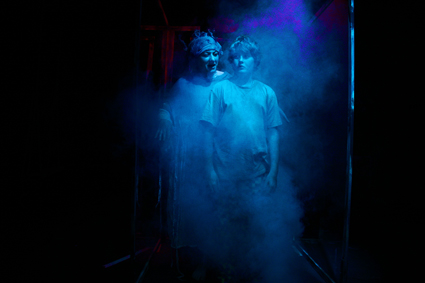Revealing the invisible
Annemaree Dalziel: Lieder Theatre, Comin’ Home Soon

Lieder Theatre, Comin’ Home Soon
At Goulburn’s Lieder Theatre in regional New South Wales on a cold May night I see a verbatim theatre work, Comin’ Home Soon, created from workshops and interviews with prisoners and their families.
Operating continuously in Goulburn since 1891, this regional community theatre is almost as old as the gaol, if not its penal history. In 1884, a massive hand-carved sandstone prison gate and façade designed by colonial architect James Barnet was completed. Such impressive architecture replaced Goulburn’s earliest buildings, a lock-up (1829) and a gibbet (1832), and today it is part of the architecture of surveillance and incarceration of Goulburn Correctional Centre, Australia’s highest security prison. Coming into Goulburn from the north, you can’t miss it—bleak and exposed.
The staging is harsh, defined by an oblique back wall, rough-painted grey, red-streaked, an endlessly receding infinity punctured by four window-sized squares and graffitied with hundreds of counted-off days. High on the proscenium, clocks are painted, dotted—doin’ time Indigenous way?
White light evoking searchlights creates a powerful chiaroscuro of four kids playing cops and robbers. As they squabble about what their dads did and why they were caught, five teenagers walk slowly across the stage behind them. The game gets too hard, the kids give up and exit to their Playstations. More performers enter, adopting curious flower poses for a poetic chorus that contrasts floral images with the harsh life and regime of the prison. Four men enter and address us, recounting experiences of making phone calls from inside. Momentarily there are 17 people on stage.
A series of intersecting games and interactions unfolds between prisoners, their children and the people who work with them. Children contend with each other, absent parents, anger, shame, social workers, prison transport workers and guards. Prisoners describe darker games of secrecy in negotiating incarceration; a father can only speak to his reluctant child through Grizz, a soft toy. We hear promises, lost promises, the elusive promise of the title. Some games loosen up and flow but just as often paralysis takes hold of characters struggling to communicate, as prison life imposes an implacable social straitjacket. How does a long-term inmate relate to his daughter’s account of going to see Lady Gaga?
Alana Valentine’s script structures dense layers of verbatim material by constantly intercutting five defined ‘states.’ The sometimes earnest and awkward delivery by these community actors heightens the sense of authenticity in their performances. Darkly costumed in a monochrome world of grey and black, they criss-cross diagonally between ‘states’ and narrative strands. As ‘states’ shift, the work drives forward. The chords, discordant sound and sustained notes of the score hold the tension throughout, driving the oblique and unsentimental emotional tenor of the work.
The four windows puncturing the back wall open in sequence as prisoners address the audience directly. A slippery dip and swing are play sites, entry and exit points. Mobile frames become X-Ray machine gates. In the only scenes to use colour Nervous Nathan’s fears are physicalised in a fantastical and surreal series of interludes with Gymea lilies called Lillianspooks, a frill-necked lizard and blue-and-white mist.
In a short ‘state’ with didjeridu—a reference to the over-representation of Indigenous people in Australian prisons—the four inmates talk of encountering their Aboriginal culture while in prison and of hunger for ceremony, initiation, language, lore. They speak of regrets for ignoring culture and old people in their youth as they tried to live ‘white-fella way.’ A woman speaks to children about reading Aboriginal painting. So much hangs unsaid. The final scene, a game like Statues, draws all 17 performers into trying their luck at winning—at Comin’ Home Soon.
The play is raw, a first draft followed by one reading and a rewrite. It is intelligent, well-crafted work, emphatic in its clarity, integrity and passionate sense of necessity. The direction, design and sound are sophisticated and the commitment and performances of the ensemble impress. Seven cast members identify as Bundjalung, Wiradjuri, Darug or Bidgigal; five are performing with Lieder for the first time; all are volunteers and locals, visibly determined that their story be heard and seen locally, making the invisible visible. This is the legacy of this community, Lieder Theatre and artistic director Chrisjohn Hancock.
Goulburn jail is harsh, surveillance is constant and punitive but Comin’ Home Soon and the extraordinary local participation undercut that sense of it by reminding us of the humanity of the people incarcerated within its walls.
Lieder Theatre, Comin’ Home Soon, writer Alana Valentine, director, designer, lighting Chrisjohn Hancock, commissioned by Goulburn Regional Art Gallery; Lieder Theatre, Goulburn, NSW, 26 April-11 May
RealTime issue #116 Aug-Sept 2013 pg. 44






